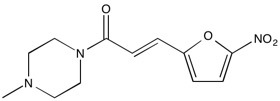NSC59984 | p53 activator
NMR (Conforms)

Available Options
| Size : | Price | Quantity | |
|---|---|---|---|
| 5 mg | $60.00 | ||
| 25 mg | $200.00 |
NSC59984 (803647-40-7) is a p53 activator. Restores wild-type p53 signaling and depletes mutant p53 gain of function. Induces mutant p53 protein degradation via MDM2 and ubiquitin-proteasome pathway. Induces p73-dependent cell death in cancer cells without toxicity toward normal cells.1 Inhibition of p53-MDM2 interaction remains a viable strategy for cancer therapeutic development.2,3
References/Citations:
1) Zhang et al. (2015), Small-Molecule NSC59984 Restores p53 Pathway Signaling and Antitumor effects against Colorectal Cancer via p73 Activation and Degradation of Mutant p53; Cancer Res., 75 3842
2) Ferraiuolo et al. (2016), Oncogenic Intra-p53 Family Member Interactions in Human Cancers; Front. Oncol., 6 77
3) Hong et al. (2014), Targeting tumor suppressor p53 for cancer therapy: strategies, challenges and opportunities; Curr. Drug Targets, 15 80
NMR (Conforms)
Safety Data Sheet:
Product Data Sheet:
Materials provided by Focus Biomolecules are for laboratory research use only and are not intended for human or veterinary applications. Please note that we do not sell to individuals and that all orders placed by non-research organizations will incur a $20 restocking/refund fee
NSC59984 (803647-40-7) is a p53 activator. Restores wild-type p53 signaling and depletes mutant p53 gain of function. Induces mutant p53 protein degradation via MDM2 and ubiquitin-proteasome pathway. Induces p73-dependent cell death in cancer cells without toxicity toward normal cells.1 Inhibition of p53-MDM2 interaction remains a viable strategy for cancer therapeutic development.2,3
References/Citations:
1) Zhang et al. (2015), Small-Molecule NSC59984 Restores p53 Pathway Signaling and Antitumor effects against Colorectal Cancer via p73 Activation and Degradation of Mutant p53; Cancer Res., 75 3842
2) Ferraiuolo et al. (2016), Oncogenic Intra-p53 Family Member Interactions in Human Cancers; Front. Oncol., 6 77
3) Hong et al. (2014), Targeting tumor suppressor p53 for cancer therapy: strategies, challenges and opportunities; Curr. Drug Targets, 15 80
Calculate the molar concentration, mass or volume in a solution.
Concentration × Volume × Molecular Weight = Mass
Focus Biomolecules • Plymouth Meeting, PA USA • 1-855-FOCUS21
Focus Biomolecules
Plymouth Meeting, PA USA
1-855-FOCUS21
Website Created by Advanta Advertising LLC.

